Tag Archives: catalytic-gac

Whole House Water Filter Catalytic-GAC Blend Fleck 5600 1.5 CU-KDF85MG4
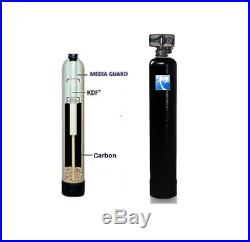
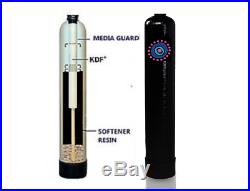
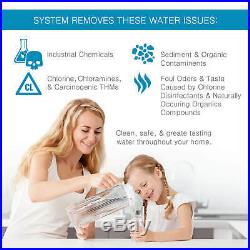
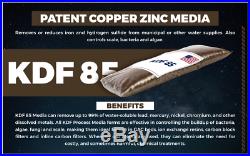
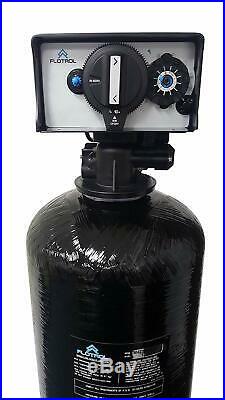
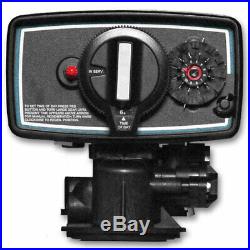
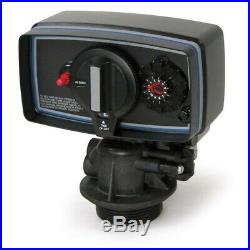

Point-of-Entry water treatment systems are installed on your side of the meter with the express purpose of treating all of the incoming water before it goes into the individual supply lines that feed your laundry, bathrooms (including toilets), dedicated outside faucets and others as well as your kitchen. POE systems often include softeners, large bed carbon filters, and some systems which are specifically designed to remove (or trap) sediment, foul tastes and odors. POE systems are sometimes considered pre-filters. Whole House Water Filter With consistently superior KDF85 medium is a economical pretreatment unit which is able to turn your water filter in to a high performance water filtration system by by reducing chlorine, heavy metals and inhibits bacteria growth from water without adding chemicals. KDF 55 & KDF 85 process media can remove up to 99% of water soluble lead, mercury, nickel, chromium, chlorine and Hydrogen Sulfide and other dissolved metals. Wherever KDF Media are used, they can eliminate the need for costly and sometimes harmful chemical treatments. KDF process media are high purity copper-zinc formulations used in pre treatment, primary treatment and waste water applications. KDF media supplement or replace existing technologies to extend system life, reduce heavy metals, microorganisms, scale, lower total cost and decrease maintenance. KDF process media are recyclable and contain no chemical additives. Homes, hospitals, restaurants, municipal water treatment facilities rely on KDF process media to safely reduce or remove chlorine, iron, hydrogen sulfide, heavy metals and bacteria from water. Media-Guard KDF85 is for well water and removes/reduces soluble iron, hydrogen sulfate, chlorine, heavy metals from water and bacteria static. Good tasting water throughout the whole house. No maintenance needed on media-guard system. 1.5 CU FT Mix of Coconut Shell Granular Activated Carbon + Catalytic Carbon. Carbon is a substance that has a long history of being used to absorb impurities and is perhaps the most powerful absorbent known to man. One pound of carbon contains a surface area of roughly 125 acres and can absorb literally thousands of different chemicals. Activated carbon which has a slight electro-positive charge added to it, making it even more attractive to chemicals and impurities. As the water passes over the positively charged carbon surface, the negative ions of the of the contaminants are drawn to the surface of the carbon granules. Activated carbon filters used for home water treatment typically contain either granular activated carbon or powdered block carbon. Although both are effective, carbon block filters generally have a higher contaminant removal ratio. The two most important factors affecting the efficiency of activated carbon filtration are the amount of carbon in the unit and the amount of time the contaminant spends in contact with it. The more carbon the better. Similarly, the lower the flow rate of the water, the more time contaminants will be in contact with the carbon, and the more absorption that will take place. Particle size also affects removal rates. The most common carbon types used in water filtration are bituminous, wood, and coconut shell carbons. While coconut shell carbon typically costs 20% more than the others, it is generally regarded as the most effective of the three. All of our activated carbon filters use coconut shell carbon. There are two principal mechanisms by which activated carbon removes contaminants from water; absorption, and catalytic reduction, a process involving the attraction of negatively-charged contaminants ions to the positively-charged activated carbon. Organic compounds are removed by absorption and residual disinfectants such as chlorine and chloramines are removed by catalytic reduction. Activated carbon filtration is very common in a number of home water treatment systems. It can be used as a stand alone filter to reduce or eliminate bad tastes and odors, chlorine, and many organic contaminants in municipal (pre-treated or chlorinated) water supplies to produce a significantly improved drinking water. It is also very commonly used as a pre-treatment as part of a reverse osmosis system to reduce many organic contaminants, chlorine, and other items that could foul the reverse osmosis membrane. 0.5 block filters are commonly used to remove cysts such as giardia and cryptosporidium. Activated carbon filters remove/reduce many volatile organic chemicals (VOC), pesticides and herbicides, as well as chlorine, benzene, trihalomethane (THM) compounds, radon, solvents and hundreds of other man-made chemicals found in tap water. This unit includes the following. 10″ x 54″ Mineral Tank (Black or Almond). Fleck 5600 T imer Backwash Control Unit 110V. KDF 85 Media Guard Pre-Installed. 1.5 CU FT GAC Carbon Mix. Bypass with 1 Yoke. Hydrogen sulfide concentrations exceeding 7 to 10 ppm can be removed by injecting an oxidizing chemical such as household bleach followed up by filtration. The oxidizing chemical should enter the water upstream from the storage or mixing tank to provide at least 30-45 minutes of contact time between the chemical and water. The length of length of the holding time is a function of the chemical dosage, tank configuration and water temperature. Sulfur particles can then be removed using a sediment filter and the excess chlorine can be removed by activated carbon filtration. If test results indicate that bacterial contamination is occurring, shock chlorination or disinfection is the most widely suggested method for initial treatment. Shock chlorination (disinfection) is the one-time introduction of a strong solution into the entire water distribution system well, pump, distribution pipeline, etc. When to Shock Disinfect the Well. Shock chlorination (disinfection) is recommended when lab results indicate a presence of bacteria upon completion of a new well or after pump replacement or repair, when the distribution system is opened for repairs or maintenance, following contamination by flood water, to control iron and sulfur bacteria. Shock chlorination (disinfection) is recommended in these circumstances to ensure that bacterial contamination is controlled. This system should be used where low to moderate ferrous (dissolved) iron or hydrogen sulfide contamination is known. This filter is most effective where iron and hydrogen sulfide levels are less than 5 ppm. Best removal rates are achieved where pH is between 6.5 and 8.5 and where water contains some dissolved oxygen. Track Page Views With. Auctiva’s FREE Counter. The item “Whole House Water Filter Catalytic-GAC Blend Fleck 5600 1.5 CU-KDF85MG4″ is in sale since Wednesday, April 17, 2019. This item is in the category “Home & Garden\Kitchen, Dining & Bar\Small Kitchen Appliances\Water Purification\Water Filters”. The seller is “oceanicwatersystems7″ and is located in North Hollywood, California. This item can be shipped worldwide.
- Model: Does Not Apply
- Country/Region of Manufacture: United States
- Filtration Method: Carbon/Charcoal, KDF 85
- Type: Water Filter
- Color: Black
- MPN: TWPVORTECH
- Brand: Oceanic Water Systems
- Power: 110V

Whole House Water Filter Catalytic-GAC Blend Fleck 5600 1.5 CU-KDF85MG4
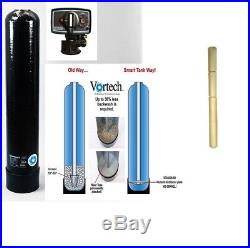

Point-of-Entry water treatment system is installed on your side of the meter with the express purpose of treating all of the incoming water before it goes into the individual supply lines that feed your laundry, bathrooms (including toilets), dedicated outside faucets and others as well as your kitchen. POE systems often include softeners, large bed carbon filters, and some systems which are specifically designed to remove (or trap) sediment, foul tastes and odors. POE systems are sometimes considered pre-filters. Whole House Water Filter With consistently superior KDF85 medium is a economical pretreatment unit which is able to turn your water filter in to a high performance water filtration system by by reducing chlorine, heavy metals and inhibits bacteria growth from water without adding chemicals. KDF 55 & KDF 85 process media can remove up to 99% of water soluble lead, mercury, nickel, chromium, chlorine and Hydrogen Sulfide and other dissolved metals. Wherever KDF Media are used, they can eliminate the need for costly and sometimes harmful chemical treatments. KDF process media are high purity copper-zinc formulations used in pre treatment, primary treatment and waste water applications. KDF media supplement or replace existing technologies to extend system life, reduce heavy metals, microorganisms, scale, lower total cost and decrease maintenance. KDF process media are recyclable and contain no chemical additives. Homes, hospitals, restaurants, municipal water treatment facilities rely on KDF process media to safely reduce or remove chlorine, iron, hydrogen sulfide, heavy metals and bacteria from water. Media-Guard KDF85 is for well water and removes/reduces soluble iron, hydrogen sulfate, chlorine, heavy metals from water and bacteria static. Good tasting water throughout the whole house. No maintenance needed on media-guard system. 1.5 CU FT Coconut Shell Granular Activated Carbon. Carbon is a substance that has a long history of being used to absorb impurities and is perhaps the most powerful absorbent known to man. One pound of carbon contains a surface area of roughly 125 acres and can absorb literally thousands of different chemicals. Activated carbon which has a slight electro-positive charge added to it, making it even more attractive to chemicals and impurities. As the water passes over the positively charged carbon surface, the negative ions of the of the contaminants are drawn to the surface of the carbon granules. Activated carbon filters used for home water treatment typically contain either granular activated carbon or powdered block carbon. Although both are effective, carbon block filters generally have a higher contaminant removal ratio. The two most important factors affecting the efficiency of activated carbon filtration are the amount of carbon in the unit and the amount of time the contaminant spends in contact with it. The more carbon the better. Similarly, the lower the flow rate of the water, the more time contaminants will be in contact with the carbon, and the more absorption that will take place. Particle size also affects removal rates. The most common carbon types used in water filtration are bituminous, wood, and coconut shell carbons. While coconut shell carbon typically costs 20% more than the others, it is generally regarded as the most effective of the three. All of our activated carbon filters use coconut shell carbon. There are two principal mechanisms by which activated carbon removes contaminants from water; absorption, and catalytic reduction, a process involving the attraction of negatively-charged contaminants ions to the positively-charged activated carbon. Organic compounds are removed by absorption and residual disinfectants such as chlorine and chloramines are removed by catalytic reduction. Activated carbon filtration is very common in a number of home water treatment systems. It can be used as a stand alone filter to reduce or eliminate bad tastes and odors, chlorine, and many organic contaminants in municipal (pre-treated or chlorinated) water supplies to produce a significantly improved drinking water. It is also very commonly used as a pre-treatment as part of a reverse osmosis system to reduce many organic contaminants, chlorine, and other items that could foul the reverse osmosis membrane. 0.5 block filters are commonly used to remove cysts such as giardia and cryptosporidium. Activated carbon filters remove/reduce many volatile organic chemicals (VOC), pesticides and herbicides, as well as chlorine, benzene, trihalomethane (THM) compounds, radon, solvents and hundreds of other man-made chemicals found in tap water. This unit includes the following. 10″ x 54″ Mineral Tank (Black or Blue). Fleck 5600 T imer Backwash Control Unit 110V. KDF 85 Media Guard. 1.5 CU FT GAC Carbon. Bypass with 1 Yoke. Hydrogen sulfide concentrations exceeding 7 to 10 ppm can be removed by injecting an oxidizing chemical such as household bleach followed up by filtration. The oxidizing chemical should enter the water upstream from the storage or mixing tank to provide at least 30-45 minutes of contact time between the chemical and water. The length of length of the holding time is a function of the chemical dosage, tank configuration and water temperature. Sulfur particles can then be removed using a sediment filter and the excess chlorine can be removed by activated carbon filtration. If test results indicate that bacterial contamination is occurring, shock chlorination or disinfection is the most widely suggested method for initial treatment. Shock chlorination (disinfection) is the one-time introduction of a strong solution into the entire water distribution system well, pump, distribution pipeline, etc. When to Shock Disinfect the Well. Shock chlorination (disinfection) is recommended when lab results indicate a presence of bacteria upon completion of a new well or after pump replacement or repair, when the distribution system is opened for repairs or maintenance, following contamination by flood water, to control iron and sulfur bacteria. Shock chlorination (disinfection) is recommended in these circumstances to ensure that bacterial contamination is controlled. This system should be used where low to moderate ferrous (dissolved) iron or hydrogen sulfide contamination is known. This filter is most effective where iron and hydrogen sulfide levels are less then 5 ppm. Best removal rates are achieved where pH is between 6.5 and 8.5 and where water contains some dissolved oxygen. High flow design maximizes today’s high efficiency control valve technology. Environmentally friendly, reduces backwash requirement by up to 30%. No channeling of media, providing a cleaner more efficient system. Permanent attachment of the dip tube makes servicing the control valve easy by keeping the distributor in place, no more re-bedding. Distributor plate is designed for over 6,500 lbs. Titan Water Pro is your “Clean Water Solutions”. The item “Whole House Water Filter Catalytic-GAC Blend Fleck 5600 1.5 CU-KDF85MG4″ is in sale since Tuesday, November 28, 2017. This item is in the category “Home & Garden\Kitchen, Dining & Bar\Small Kitchen Appliances\Water Filters”. The seller is “titanwaterpro” and is located in Canyon Country, California. This item can be shipped to United States, Canada, United Kingdom, Denmark, Romania, Slovakia, Bulgaria, Czech republic, Finland, Hungary, Latvia, Lithuania, Malta, Estonia, Australia, Greece, Portugal, Cyprus, Slovenia, Japan, China, Sweden, South Korea, Indonesia, Taiwan, South africa, Thailand, Belgium, France, Hong Kong, Ireland, Netherlands, Poland, Spain, Italy, Germany, Austria, Israel, Mexico, New Zealand, Singapore, Switzerland, Norway, Saudi arabia, Ukraine, United arab emirates, Qatar, Kuwait, Bahrain, Croatia, Malaysia, Brazil, Chile, Colombia, Costa rica, Panama, Trinidad and tobago, Guatemala, Honduras, Jamaica.
- Type: Whole House Well Water
- Filtration Method: Carbon/Charcoal
- Number of Filtrations: 3
- Brand: TWP
- MPN: TWPVORTECH
- Power: 110V
- Color: Multi-Color
- Model: TWPVORTECH
